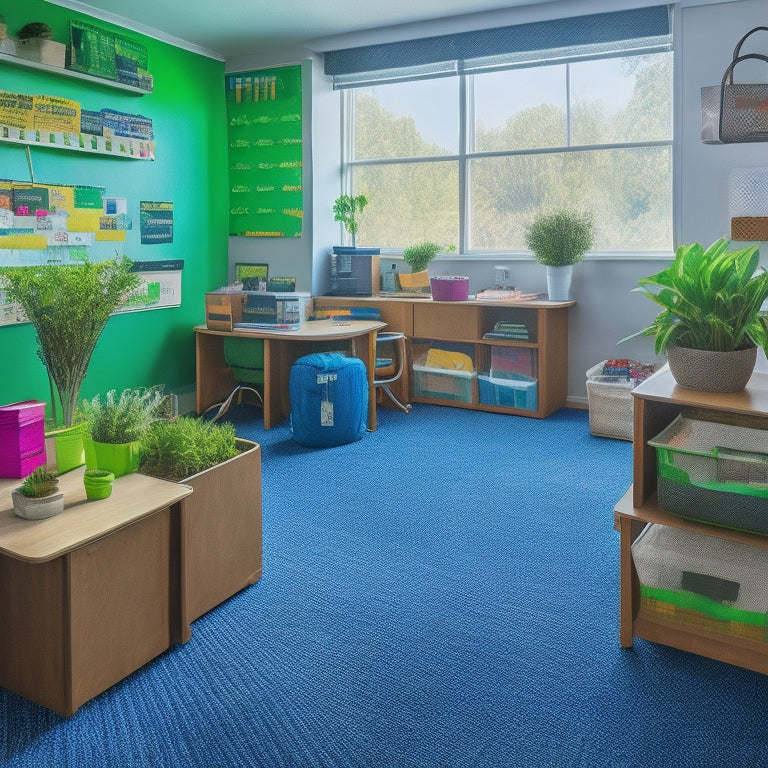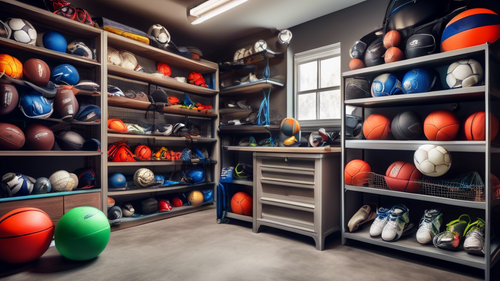
Mastering Classroom Organization: Teachers' Ultimate Guide
Share
Effective classroom organization is the foundation upon which engaged learning, autonomy, and safety are built. A well-organized classroom promotes exploration, independence, and engagement, while also teaching valuable life skills. By involving students in organization and maintenance, you can foster a sense of ownership and responsibility. Key principles include proper furniture arrangement, visual cues, and clear labeling of storage areas. By optimizing storage space, designing effective learning centers, and setting up an efficient classroom, you can create a safe and accessible learning environment that encourages discovery, wonder, and growth. Reveal the full potential of your classroom by exploring these essential elements further.
Key Takeaways
• Effective classroom organization promotes exploration, independence, and engagement while ensuring safety and accessibility for all students.
• Labels, visual cues, and clear signage help students identify and access materials, fostering autonomy and responsibility.
• Well-designed learning centers with rotated materials and regular maintenance encourage active participation, curiosity, and creativity.
• Thoughtful physical space arrangement, including vertical storage solutions and defined learning areas, supports learning and organization.
• Regular cleaning, disinfection, and emergency preparedness ensure a safe and healthy learning environment.
Classroom Organization Principles
Effective classroom organization hinges on the implementation of several key principles. Proper furniture arrangement, the use of visual cues, and labels, and the involvement of children in maintaining organization all have a profound impact on exploration, independence, engagement, and safety.
By incorporating visual cues, such as pictures or icons, students can quickly identify where materials are stored, promoting autonomy and reducing frustration. Additionally, involving students in maintaining organization encourages a sense of ownership and responsibility, teaching them valuable life skills.
Optimizing Storage Space
Maximizing storage space in the classroom requires a thoughtful and intentional approach to furniture arrangement. This involves visualizing the available storage space and furniture arrangement for spatial efficiency. Ensuring that every available inch is utilized to its full potential is key to maximizing storage space. Utilizing classroom walls for additional storage options is also crucial.
Some effective strategies for optimizing storage space include:
- Implementing creative shelving solutions that maximize vertical storage
- Utilizing space saving solutions such as dividers, pull-out racks, and in-cabinet storage
- Labeling storage areas clearly to facilitate easy access and understanding
- Incorporating vertical storage bins, bookshelves, and wall-mounted options to save floor space
Effective Learning Centers
Well-designed learning centers play an important role in promoting exploration, independence, and engagement among children, while also helping to maintain a sense of organization and structure in the classroom. Effective learning center design involves creating spaces that encourage active participation, curiosity, and creativity.
To maintain engagement, it's essential to implement material rotation, where materials are regularly swapped out to keep the environment fresh and exciting. This also helps prevent boredom and stagnation.
Additionally, regular maintenance of learning centers is crucial to ensure they remain organized and clutter-free. By doing so, teachers can create an environment that fosters a sense of discovery and wonder, while also promoting a sense of responsibility and ownership among children.
Efficient Classroom Setup
By thoughtfully arranging the physical space and strategically selecting storage solutions, teachers can create an efficient classroom setup that supports both learning and organization. This involves rearranging furniture to define learning centers and promote specific activities. Utilize vertical storage solutions such as shelves and bins to maximize space.
Effective space utilization is key to creating an organized and functional classroom. Implement space-saving solutions like dividers and pull-out racks to optimize storage efficiency. Consider the flow of traffic in the classroom when arranging furniture and storage solutions.
Safety and Accessibility Essentials
In a classroom where safety and accessibility are paramount, teachers must carefully consider the physical environment to guarantee that it supports the needs of all students while minimizing potential hazards. A well-organized classroom not only promotes learning but also secures the well-being of students. To achieve this, teachers can implement safety protocols and accessibility strategies, such as clear walkways, adaptive furniture, and accessible storage.
| Safety Protocols | Accessibility Strategies | Benefits |
|---|---|---|
| Secure heavy furniture and equipment | Adaptive seating options | Reduces injury risk, promotes comfort |
| Clear walkways and emergency exits | Visual cues for navigation | Enhances evacuation safety, supports independence |
| Soft flooring and padding | Adjustable shelving and storage | Reduces fall injuries, increases accessibility |
| Regular cleaning and disinfection | Technology integration for inclusivity | Prevents illness spread, promotes equal access |
| Emergency response plans | Multisensory learning materials | Ensures preparedness, caters to diverse learning styles |
Frequently Asked Questions
How Do I Handle Classroom Organization When Sharing a Room With Another Teacher?
When sharing a room with another teacher, establish collaborative scheduling to guarantee smooth changes, implement effective communication strategies to avoid conflicts, and designate shared storage areas while creating personalized spaces for each teacher's unique needs.
What Are Some Strategies for Organizing Digital Resources and Online Materials?
Imagine a digital library where resources are neatly categorized and easily accessible. To achieve this, implement effective file management systems, leverage online tools like cloud storage and digital binders, and prioritize time management to avoid digital clutter.
Can I Involve Parents in Maintaining Classroom Organization and How?
To involve parents in maintaining classroom organization, consider volunteer opportunities for supply organization, labeling, and setup. Foster collaboration through regular communication, such as newsletters or parent-teacher conferences, to encourage parent involvement and support.
How Often Should I Reassess and Adjust My Classroom Organization System?
To maintain a best classroom organization system, regularly reassess its effectiveness, making changes as needed to find a balance between flexibility and consistency, ensuring a functional and engaging learning environment that supports student growth and development.
What Are Some Budget-Friendly Alternatives for Purchasing Organizational Supplies?
For budget-friendly alternatives, consider DIY solutions like repurposing household items or creating your own labels. Thrift store finds, such as baskets or bins, can also provide affordable and creative storage solutions, allowing you to optimize your classroom organization without breaking the bank.
Related Posts
-

Sports Equipment Organization for the Garage
Sports Equipment Organization for the Garage: A Comprehensive Guide As an avid sports enthusiast, I know firsthand...
-

Why You Need a Pro in Closet Design Online
You're tired of cluttered closets and wasted space. That's where a professional closet design expert comes in. They'l...
-

Streamline Your Small Bathroom With These Systems
You can reveal your small bathroom's hidden potential by implementing a few strategic systems that maximize every inc...


